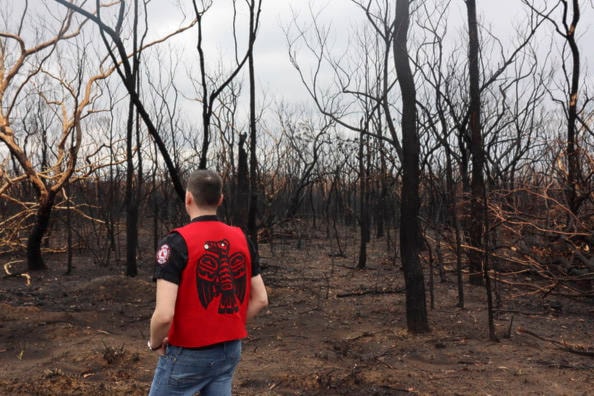Two Yukon First Nations firefighters have returned from Australia with a renewed sense of purpose and a desire to expand on the relationship built with Aboriginal communities there.
“It is our duty to be stewards of the land,” said Yukon First Nations Wildfire CEO Chad Thomas in a Jan. 27 interview.
Thomas and Jordan Profeit, the organization’s sustained action resource manager, spent two weeks in Australia meeting with Aboriginal communities impacted by the wildfires that are burning throughout the country.
An unprecedented fire season has claimed at least 33 lives since September, destroyed more than 3,000 homes and razed more than 10.6 million hectares (26.2 million acres).
Thomas and Profeit’s journey came out of a partnership Tahltan Strong, the organization that raised funds in 2018 for recovery work in Telegraph Creek, B.C. following wildfires there, has with the Yuin Aboriginal people in New South Wales.
Over the course of the two weeks, Thomas and Profeit met with Aboriginal communities and organizations, visiting their traditional territories, areas of cultural significance and learned about the impact of the fires.
“It all kind of happened really fast,” Thomas said, pointing out the importance of taking the opportunity to support Australia’s Aboriginal communities as they dealt with the impact of the nation’s bushfires.
The knowledge gained as they were welcomed into those Aboriginal communities is something that will impact their own approach to firefighting and what they see as their role, the pair said.
“They consider themselves custodians of the land,” Thomas said.
| Chad Thomas, Yukon First Nations Wildfire CEO, right, and Jordan Profeit, Yukon First Nations Wildfire sustained action resource manager, centre, are photographed with Simon Heestra, head of New South Wales rural fire department during their mission to Australia earlier in January. (Submitted) |
Many of those they spoke to talked of interconnectedness of the land and wildlife, expressing grief for the animals that had died or lost their habitat in the fires.
“It hurt them deep in their souls,” Thomas said.
There’s also going to be a major impact on traditional medicines with the loss of plant life from the fires. In some cases it’s “very possible” that certain types of medicines may be wiped out.
“That’s going to be another loss,” Profeit said,
Thomas described their two weeks as “more a journey than a trip.” And despite the Yukon and Australian communities being half a world away from each other, there were many legends that seemed familiar, Profeit said. The crow stories he heard were similar to the raven legends in the Yukon.
Along with sharing their legends and stories, those they visited shared their land and culture, taking Profeit and Thomas to places of cultural significance that aren’t typically shared with tourists.
“They took us right in,” Thomas said as he recalled the welcome and farewell ceremonies hosted for them.
Many of the community leaders they met were better known as Uncle and Auntie with the two Yukoners instructed to call them by the familial titles as well.
Thomas and Profeit spent many 16-hour days meeting with the communities and service organizations that work to support Aboriginal communities and visiting their territories. It was through these connections that the two Yukoners learned more about cultural burning where low intensity fires would be lit to burn off brush and revitalize the land.
As Thomas explained, it has an impact similar to firesmarting in preventing large wildfires from reaching populated areas.
| Chad Thomas, Yukon First Nations Wildfire CEO, and Jordan Profeit, Yukon First Nations Wildfire sustained action resource manager, document a bridge burned by wildfire in Australia earlier in January. (Submitted) |
Like many Indigenous practices, cultural burning was largely ended with colonialism. Aboriginal communities are now once again practicing the custom though.
Many believe the practice helped keep the number of major brush fires from becoming the “super, mega” fires that are raging through the country now.
Groups like the Fire Sticks Alliance Indigenous Corporation are working to facilitate and reinvigorate cultural burning.
Profeit recalled visiting one site where cultural burning has been practiced regularly in recent years. There, the wildfire that had been approaching petered out as it reached the site.
“It stopped in areas (like that),” Profit said.
The Yukon duo also learned about other ways of managing fire, noting in Australia firefighters tend to walk beside where the fire is burning while the North American practice in fighting fires is for firefighters to go in behind the fire.
They also met with Aboriginal youth being mentored by the older generation and learning how to become caretakers of the land.
“It was a very amazing experience,” Thomas said.
It’s an experience that has Thomas and Profeit excited for possibilities in the Yukon.
“I think this is the start of something truly amazing,” Thomas said as he and Profeit spoke of their hope to continue efforts mentoring Yukon First Nation youth interested in becoming firefighters through its Beat The Heat program as well as the potential for exchange programs with their Australian counterparts, a move that could strengthen the new relationships that have been built.
The pair also said they hope to work towards having more Indigenous knowledge applied to dealing with fires in the North with First Nations having a “seat at the table” when it comes to planning for major wildfires, something that’s a matter of “when not if” in the Yukon as the impacts of climate change continue to be experienced.
“We might see a lot of change — change for the good,” Profeit said.
With files from the Associated Press
Contact Stephanie Waddell at stephanie.waddell@yukon-news.com
